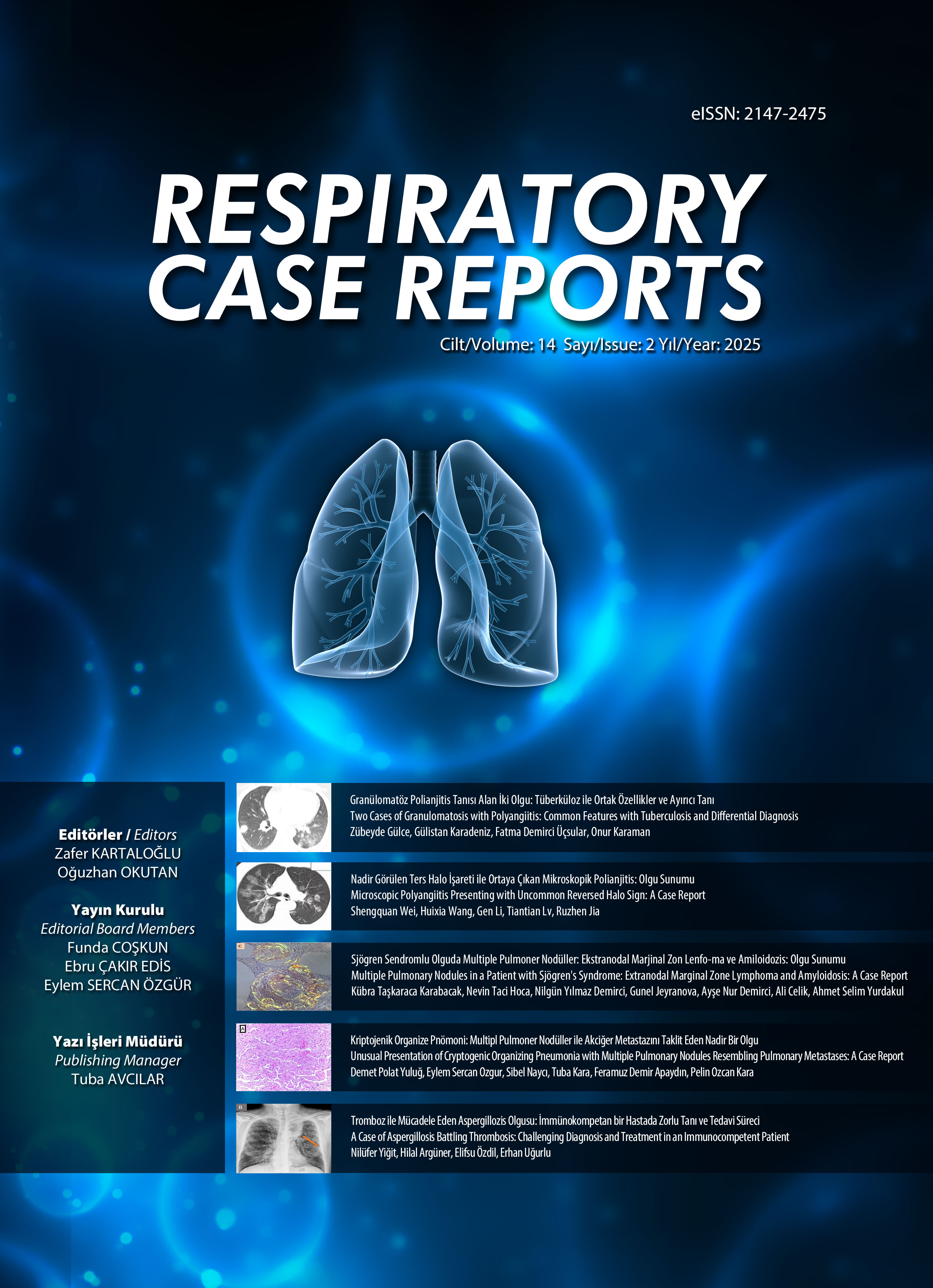e-ISSN 2147-2475

Volume: 8 Issue: 3 - October 2019
| CASE REPORT | |
| 1. | Massive Disseminated Tuberculosis in an Immunocompetent Patient: Early Diagnostic and Empiric Treatment Approach from an Endemic Country: Indonesia (A Case Report and Literature Review) Allen Widysanto, Audrey Suryani Soetjipto, Nata Pratama Lugito doi: 10.5505/respircase.2019.09825 Pages 86 - 93 Tuberculosis is still rampant, despite the centuries of efforts to conquer it. Indonesia is host to the third highest TB burden in the world, with an uneven distribution of health care access, and especially to highly sensitive and specific molecular investigations. Rapid and accurate TB diagnosis is crucial for the control of the infection. An AFB smear test is easily accessed and is cost-effective, although there are a number of shortcomings with the approach. We report here on a case of negative acid-fast bacilli (AFB) smear disseminated tuberculosis (TB) in a previously healthy 23-year-old Indonesian female who presented to a secondary care facility with pulmonary, pericardial, peritoneal, utero-ovarian, genitourinary and splenic involvement. The clinician chose to start anti-tuberculosis therapy without a positive microbiology and biopsy for bacterial load containment purposes, considering also the patients clinical and endemic epidemiology. The diagnosis was confirmed with a positive mycobacterial culture after the initiation of anti-tuberculosis therapy. In the present study, we also review the diagnosis of 20 other cases of disseminated tuberculosis reported in other countries. |
| 2. | A Case of Acute Idiopathic Non-specific Pneumonia with Dramatic Response to Treatment Gulsah Gunluoglu, Fatma Esra Günaydın, Halide Nur Urer, Nurdan Kalkan, Nurdan Şimşek Veske, Sedat Altın doi: 10.5505/respircase.2019.52296 Pages 94 - 98 Non-specific interstitial pneumonia (NSIP) is a form of idiopathic interstitial pneumonia with a specific histological pattern involving varying degrees of alveolar wall inflammation or fibrosis, and with a temporal uniformity of lesions. The organized component can be found at different degrees, and the presence of a histologically organized component does not exclude a diagnosis of NSIP. Acute respiratory failure is rare in NSIP. A female patient who presented to our clinic with radiological findings of widespread consolidation and acute respiratory failure was diagnosed with NSIP with organized pneumonia through a surgical lung biopsy. The patient responded rapidly to steroid therapy, and the clinical findings improved dramatically. We present our case in order to emphasize the importance of treatment in the event of respiratory failure in idiopathic NSIP with organized pneumonia, and recommend rapid diagnosis and treatment. |
| 3. | A Rare Complication of Chronic Constipation: Lipoid Pneumonia Berna Duman, Ali Vefa öztürk, Ipek Coban, Tugba Cosgun, Alper Toker, Levent Dalar doi: 10.5505/respircase.2019.40326 Pages 99 - 102 Lipoid pneumonia is a rare lung disease. Consuming mineral oils for the specific treatment of chronic constipation can lead to aspiration. Herein, a case of lipoid pneumonia is presented resulting from the consumption of olive oil to treat constipation. A 70-year-old male referred with a cough and sputum expectoration. A patchy ground glass opacity was noted in right lower lobe posterobasal segment and the middle lobe in a thoracic computerized tomography (CT). The findings persisted in the middle lobe after broad spectrum antibiotherapy. An examination of the bronchoalveolar lavage fluid was inconclusive. A loss of volume was noted in the middle lobe in a new CT. A middle lobectomy was carried out, and the pathological examination revealed lipoid pneumonia. Under deep questioning, the patient disclosed that he consumed olive oil every morning for chronic constipation. Lipoid pneumonia can be an alternative diagnosis for ground glass opacities. Consuming mineral oil should be avoided, especially in the elderly and children, and in patients with impaired swallowing, reflux or neurological disorders. |
| 4. | Can Pneumothorax be the Cause of Aspergilloma? Onur Derdiyok, Levent Alpay, Volkan Baysungur doi: 10.5505/respircase.2019.34713 Pages 103 - 106 Bullectomy and pleurodesis are frequently used for the surgical treatment of spontaneous pneumothorax. Bullectomy and pleurodesis are combined to prevent recurrence, but when pleurodesis causes chest wall and bullous lung neovascularization, it is applied particularly to the apical region. The resulting sterile area, however, may lead to many complex clinical problems, such as aspergillus. In the present study we present a case who underwent a right upper lobectomy due to hemoptysis complications related to aspergilloma, arising from the sterile space in the right hemithorax after a tube thoracostomy performed 7 years previously. |
| 5. | Pulmonary Spindle Cell Sarcomatoid Carcinoma: A Case Report Nesrine Fahem, Ahmed Ben Saad, Rania Kaddoussi, Manel Njima, Asma Migaou, Saoussen Cheikh Mhamed, Samah Joobeur, Naceur Rouatbi doi: 10.5505/respircase.2019.26539 Pages 107 - 110 Primary lung sarcomatoid carcinoma (SC) is a rare malignant tumor, with spindle-cell SC representing one subtype of this histological category, only few cases of which have been reported in literature. The treatment and prognosis of pulmonary SC have yet to be clearly determined. Herein we report on the case of a 40-year-old patient with a complaint of chest pain who was found to have a left apical mass in a chest computed tomography (CT). CT-guided lung biopsy and immunohistochemistry confirmed the diagnosis of spindle-cell SC. After radio-chemotherapy, the patient showed an initial partial response and then tumor progression. |
| 6. | Primary Pulmonary Leiomyosarcoma: A Case report Ilgin Timarci, Gülistan Karadeniz, Gulru Polat, Fatma Demirci Üçsular, Görkem Vayısoğlu Şahin, Enver Yalnız, Nur Yücel doi: 10.5505/respircase.2019.79847 Pages 111 - 114 Leiomyosarcoma is a malignant mesenchymal tumor originating from smooth muscle, and frequently from the uterus, retroperitoneum and intraabdominal region, and is of primary pulmonary origin. We present the rare case of a 43-year-old female patient with primary pulmonary leiomyosarcoma who was admitted with shortness of breath. |
| 7. | Adult Mediastinal Cystic Hygroma: A Case Report Hulya Dirol, Fatma Deniz, Aykut Cilli, Levent Dertsiz doi: 10.5505/respircase.2019.00921 Pages 115 - 118 Cystic hygroma is an uncommon congenital malformation of the lymphatic system that is composed of dilated and fluid-filled lymphatic vessels. It is thought to occur due to a blockage in the lymphatic system during the developmental stage. Most are located in the neck, although they can also present in the axilla and mediastinum. Isolated mediastinal cystic hygroma is a very rare pathology in adults, with complete surgical excision being the treatment of choice. The lesion and the surrounding tissue must be fully resected due to the high recurrence rates associated with incomplete resections. In cases where a total excision is impossible, radiotherapy, aspiration, sclerosing injections, systemic chemotherapy and interferon-α are the other treatment options. Here, we report on a case with an incidentally detected mediastinal cystic hygroma, presenting the results of a four-year follow up after a complete resection. |
| 8. | Bronchopulmonary 'Pseudo' Sequestration Nur Erik, Şeyma Başlılar, Sedef Kaya, Bengü Şaylan doi: 10.5505/respircase.2019.33603 Pages 119 - 122 The term pulmonary sequestration refers to a wide spectrum of bronchopulmonary vascular malformations. In this case report, we present an asymptomatic case with a normal right lower lobe supplied by a branch of the celiac artery. A 23-year-old male member of the military applied for a periodical physical examination. A thorax computerized tomography (CT) scan revealed a normal right lung volume, although the right lower lobe received its blood supply from the celiac artery. A diagnosis of a congenital pseudosequestration was made, and the patient was advised to seek treatment should pulmonary symptoms develop. Bronchopulmonary sequestration was first described by Pryce, who distinguished between three types of developmental abnormality: Type I: A normal lung with anomalous systemic arterial supply, Type II: An anomalous artery supplying a disconnected lung and an adjacent normal lung, and Type III: A nonfunctional and abnormal lung with systemic arterial blood supply. Later, the Pryce Type I sequestration was renamed pseudosequestration. Congenital pseudosequestration is usually seen the in the lower lobes, and anomalous systemic blood supply arises from the descending thoracic aorta, celiac trunk or abdominal aorta. CT is the best diagnostic method. |
| 9. | Tracheal Bronchus: A Rare Anomaly Mesut Özgökçe, Fatma Durmaz, Ensar Türko, Muhammed Bilal Akıncı doi: 10.5505/respircase.2019.08760 Pages 123 - 125 Abnormal bronchi originating from the trachea or main bronchi are rare anomalies, with one of the most significant of these abnormalities being tracheal bronchus. It is usually asymptomatic, and is usually diagnosed from a computed tomography or bronchoscopy made for another reasons. The bronchial anatomy is recognized by the radiologist in order to guide possible interventions. In this case report we present a particularly rare case of tracheal bronchus, with the computed tomography findings and accompanying literature. |
| AUTHOR INDEX | |
| 10. | Author Index Pages 126 - 127 Abstract | |
| REVIEWER INDEX | |
| 11. | Reviewer Index Page 128 Abstract | |











